Georgia, a country at the crossroads of Europe and Asia, boasts a rich tapestry of history, culture, and natural beauty. Its UNESCO World Heritage Sites are a testament to this heritage, preserving architectural marvels, ancient traditions, and breathtaking landscapes. Whether you’re a history enthusiast, an architecture lover, or a nature seeker, Georgia’s World Heritage Sites offer unforgettable experiences. This guide explores Georgia’s key UNESCO World Heritage Sites, including Mtskheta, Gelati, and beyond, highlighting their significance, must-see features, and tips for visitors.
1. Historical Monuments of Mtskheta
Mtskheta, one of Georgia’s oldest cities, served as the capital during the early Georgian kingdoms. Situated just 20 kilometers northwest of Tbilisi, Mtskheta is a spiritual heartland for Georgians and a UNESCO World Heritage Site since 1997. The city is home to significant religious and historical monuments that reflect Georgia’s deep-rooted Christian heritage.
.jpg)
Key Sites in Mtskheta
a. Jvari Monastery
- Location: Perched on a hilltop overlooking the confluence of the Mtkvari and Aragvi Rivers, offering panoramic views.
- Date: 6th century
- Significance: Jvari Monastery, meaning “Monastery of the Cross,” is a masterpiece of early Georgian Christian architecture. It symbolizes the transition of Georgia to Christianity and marks the spot where Saint Nino erected a wooden cross, heralding the arrival of Christianity in the region.
- Must-See Features:
- Architectural Design: A perfect example of early Georgian ecclesiastical architecture with its cross-shaped basilica design.
- Panoramic Views: Stunning vistas of Mtskheta and the surrounding landscapes.
- Historical Frescoes: Beautiful frescoes inside the church depicting biblical scenes.
- Visiting Tips:
- Best Time to Visit: Early morning or late afternoon to avoid crowds and enjoy the best lighting for photography.
- Accessibility: A short hike or drive from Mtskheta town center; comfortable footwear is recommended if hiking.
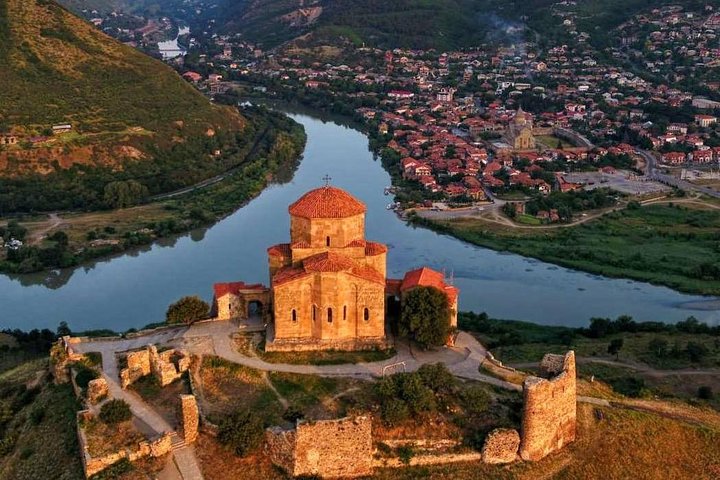
b. Svetitskhoveli Cathedral
- Location: In the center of Mtskheta, near the Mtkvari River.
- Date: Originally built in the 4th century, the current structure dates to the 11th century.
- Significance: Svetitskhoveli Cathedral is one of Georgia’s most sacred churches, believed to house the burial site of Christ’s robe. It has been a pilgrimage site for centuries and a symbol of Georgian Christianity.
- Must-See Features:
- Grand Architecture: A stunning example of Georgian ecclesiastical architecture with its high domes and intricate stone carvings.
- Rich Interiors: Elaborate frescoes and religious icons adorn the interior.
- Historical Significance: Played a central role in Georgia’s religious and political history, including coronations of kings.
- Visiting Tips:
- Dress Code: Modest attire is required when visiting religious sites; shoulders and knees should be covered.
- Guided Tours: Consider hiring a local guide to gain deeper insights into the cathedral’s history and significance.
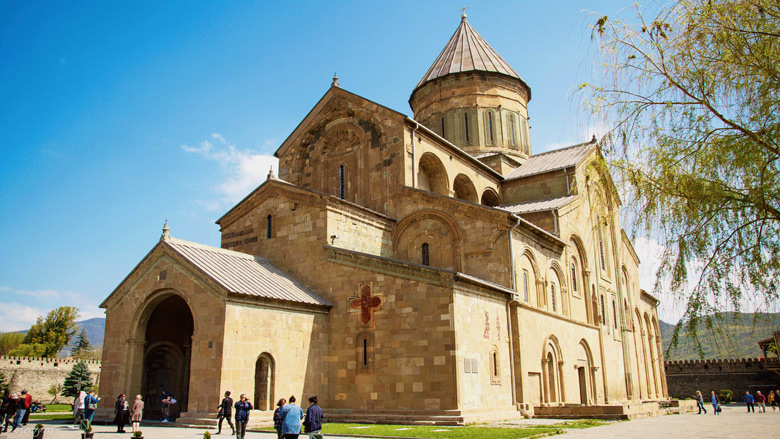
How to Get There
- From Tbilisi: Mtskheta is easily accessible by car (approximately 30 minutes) or by marshrutka (minibus) from Didube Bus Station in Tbilisi.
- Transportation Tips: Renting a car offers flexibility to explore both Jvari Monastery and Svetitskhoveli Cathedral at your own pace.
2. Bagrati Cathedral and Gelati Monastery
Located in Kutaisi, Georgia’s second-largest city, the Bagrati Cathedral and Gelati Monastery complex is a UNESCO World Heritage Site recognized since 1994. These historical landmarks exemplify Georgia’s golden age under King David the Builder and King Bagrat III, showcasing remarkable architectural and artistic achievements.
a. Bagrati Cathedral
- Location: Central Kutaisi
- Date: Originally built in the 11th century, later reconstructed
- Significance: Bagrati Cathedral symbolizes the unification of Georgian lands and the flourishing of Georgian culture and architecture during the reign of King Bagrat III. Although it suffered damage over the centuries, ongoing restoration efforts aim to preserve its legacy.
- Must-See Features:
- Architectural Grandeur: A blend of Byzantine and Georgian architectural styles, characterized by its expansive dome and intricate stonework.
- Panoramic Views: The cathedral offers breathtaking views of Kutaisi and the surrounding region.
- Historical Importance: A focal point for Georgian Orthodox Christianity and national identity.
- Visiting Tips:
- Current Status: Partially reconstructed; check the latest visitor information as restoration progresses.
- Photography: Capture the cathedral from different angles to appreciate its grandeur and the surrounding landscape.
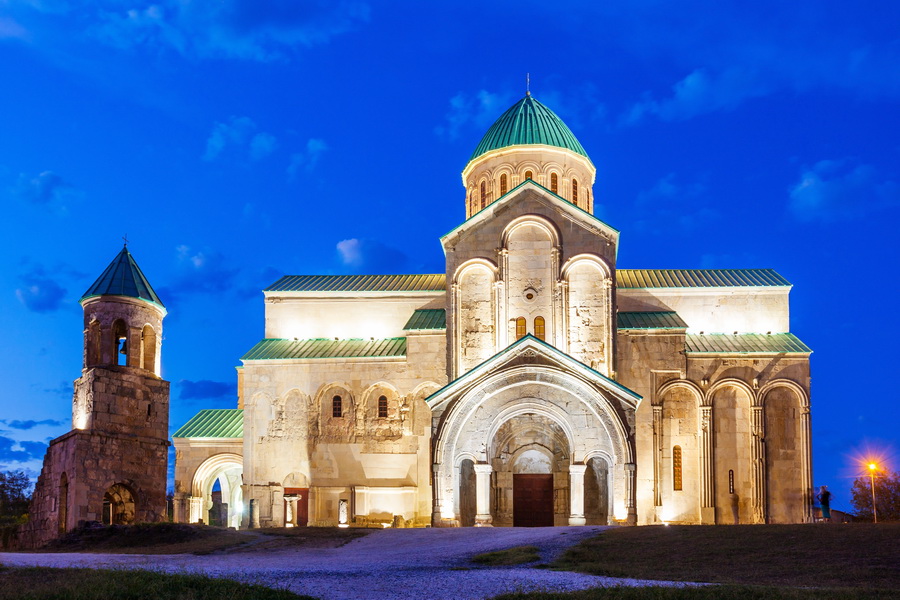
b. Gelati Monastery
- Location: Approximately 15 kilometers west of Kutaisi
- Date: Founded in 1106 by King David the Builder
- Significance: Gelati Monastery was a major center of education and culture in medieval Georgia. It served as a hub for scholars, artists, and theologians, contributing significantly to the preservation and development of Georgian culture and Orthodox Christianity.
- Must-See Features:
- Architectural Marvel: An exemplary mix of Byzantine and Georgian architectural styles with ornate frescoes and mosaics.
- Library: Historically renowned for its extensive collection of manuscripts and scholarly works.
- Beautiful Grounds: Lush gardens, courtyards, and peaceful surroundings ideal for contemplation and relaxation.
- Visiting Tips:
- Combine Visits: Easily combine a visit to Gelati Monastery with a trip to Bagrati Cathedral for a comprehensive exploration of Kutaisi’s heritage.
- Local Guides: Enhance your visit with a guided tour to fully appreciate the monastery’s historical and cultural significance.
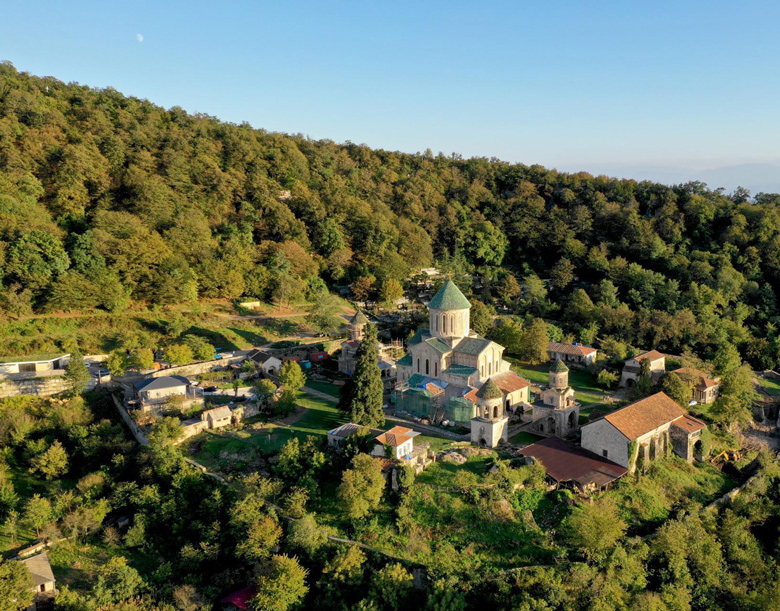
How to Get There
- From Kutaisi: Gelati Monastery is a short drive (approximately 20 minutes) from Kutaisi city center. Local taxis or rental cars are convenient options.
- Transportation Tips: Public transport options are limited; renting a car or arranging a private tour is recommended for ease of access.
3. Upper Svaneti
Upper Svaneti, encompassing the remote and picturesque region of Mestia and Ushguli, was inscribed as a UNESCO World Heritage Site in 1996. Renowned for its stunning alpine landscapes, medieval stone towers, and rich Svan culture, Upper Svaneti is a haven for nature lovers and cultural enthusiasts alike.
Key Highlights
a. Ushguli
- Location: In the Upper Svaneti region, near the village of Mestia
- Date: The settlement dates back to the 12th century
- Significance: Ushguli is one of Europe’s highest continuously inhabited settlements and one of the highest in the world. Its well-preserved medieval Svan towers reflect the region’s historical need for defense against invaders.
- Must-See Features:
- Svan Towers: Over 70 stone defensive towers, some still inhabited, offering insight into the region’s defensive architecture.
- Holy Trinity Church: A beautiful church surrounded by majestic mountain scenery.
- Natural Beauty: Breathtaking views of the Caucasus Mountains, glaciers, and pristine valleys.
- Visiting Tips:
- Accommodation: Stay in traditional guesthouses for an authentic experience.
- Hiking: Numerous trails around Ushguli provide opportunities for hiking and exploring the stunning natural surroundings.
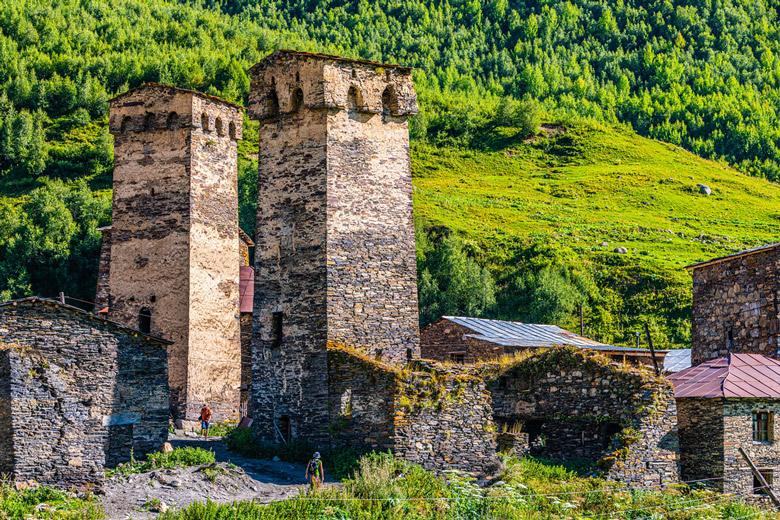
b. Mestia
- Location: The administrative center of Upper Svaneti
- Date: Historical significance as a cultural and economic hub for the Svan people
- Significance: Mestia serves as the gateway to Upper Svaneti, offering cultural attractions, museums, and access to various outdoor activities.
- Must-See Features:
- Svaneti Museum of History and Ethnography: Learn about the Svan culture, traditions, and history through extensive exhibits.
- Hiking and Adventure Sports: Opportunities for trekking, climbing, and skiing in the surrounding mountains.
- Local Cuisine: Experience traditional Svan dishes such as chvishtari (cheese-filled cornbread) and kubdari (meat-stuffed bread).
- Visiting Tips:
- Travel Season: Best visited in summer (June to September) for hiking and in winter for skiing.
- Local Interaction: Engage with locals to learn about Svan traditions and way of life.
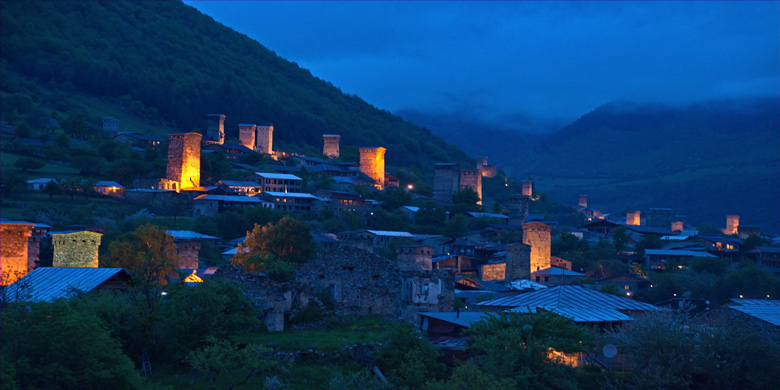
How to Get There
- From Tbilisi: Drive to Mestia via the Georgian Military Highway (approximately 8-10 hours). Alternatively, take a domestic flight from Tbilisi to Svaneti Airport (near Mestia) for quicker access.
- Transportation Tips: Due to the remote nature of Upper Svaneti, consider hiring a local guide or joining a tour group for a safer and more informative journey.
4. Vardzia Cave Monastery
Vardzia, a remarkable cave monastery complex, was declared a UNESCO World Heritage Site in 2014. Located in the Samtskhe-Javakheti region of southern Georgia, Vardzia is an architectural marvel carved into the Erusheti Mountain during the reign of Queen Tamar in the 12th century.
.jpg)
Key Highlights
- Location: Near the town of Aspindza, Samtskhe-Javakheti region
- Date: Founded in the 12th century
- Significance: Vardzia served as a major religious and political center, housing up to 2,000 monks. It played a crucial role in promoting Christianity and protecting the region from invaders
5. Gelati Monastery
(Note: Gelati Monastery is already covered under Bagrati Cathedral and Gelati Monastery. To avoid redundancy, you can skip this or integrate any additional information if necessary.)
.jpg)
6. Other Notable UNESCO Sites in Georgia
While the primary UNESCO World Heritage Sites have been covered, Georgia also has other sites that are either on the tentative list or hold significant cultural value. These include:
a. Prometheus Cave
- Location: Near Kutaisi, Imereti region
- Date: Natural formation, with historical human use
- Significance: One of Georgia’s largest and most beautiful caves, featuring stunning stalactites, stalagmites, and underground rivers. While not yet a full UNESCO site, Prometheus Cave is part of Georgia’s cultural and natural heritage.
- Must-See Features:
- Stalactites and Stalagmites: Spectacular formations that create an otherworldly atmosphere.
- Underground River: Explore the flowing water within the cave system.
- Illumination: Carefully lit pathways enhance the natural beauty of the cave.
- Visiting Tips:
- Guided Tours: Highly recommended to fully appreciate the cave’s features and history.
- Accessibility: Suitable for most visitors, with paved paths and guided assistance.
.jpg)
b. Martvili Canyon
- Location: Adjara region
- Date: Natural formation
- Significance: Martvili Canyon is a breathtaking limestone canyon with crystal-clear waters, waterfalls, and diverse flora and fauna. It’s recognized for its natural beauty and is a favorite spot for eco-tourism and outdoor activities.
- Must-See Features:
- Boat Rides: Navigate through the canyon’s serene waters, passing by impressive rock formations and lush greenery.
- Waterfalls: Marvel at the cascading waterfalls that add to the canyon’s charm.
- Hiking Trails: Explore scenic trails that offer stunning views of the canyon and surrounding landscapes.
- Visiting Tips:
- Best Time to Visit: Late spring to early autumn for the best weather and water levels.
- Facilities: Visitor centers and picnic areas are available for a comfortable visit.
.jpg)
Conclusion
Georgia’s UNESCO World Heritage Sites are a window into the country’s profound historical, cultural, and natural legacy. From the ancient streets of Mtskheta and the architectural splendor of Gelati Monastery to the remote beauty of Upper Svaneti and the awe-inspiring Vardzia Cave Monastery, each site offers a unique and enriching experience. Exploring these treasures not only provides a deeper understanding of Georgia’s past but also showcases its enduring spirit and breathtaking landscapes.
Travel Tips:
- Respect Local Customs: When visiting religious sites, adhere to dress codes and behave respectfully.
- Guided Tours: Hiring a local guide can enhance your understanding and appreciation of each site’s significance.
- Plan Ahead: Some sites may require booking or have limited visiting hours, so plan your itinerary accordingly.
- Stay Safe: Ensure you have appropriate footwear and clothing, especially when exploring remote or mountainous areas.
Start a journey through Georgia’s UNESCO World Heritage Sites and uncover the rich stories and stunning vistas that make this country a truly exceptional destination.
Enjoy your exploration of Georgia’s heritage!
